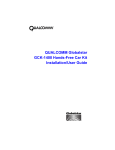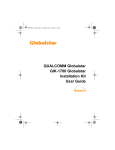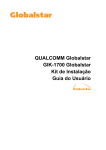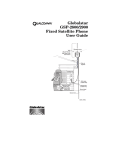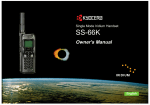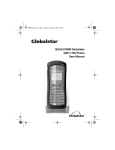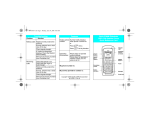Download Qualcomm Globalstar GCK-1410 User guide
Transcript
English GCK-1410 Hands-Free Car Kit User Guide This guide is based on the production version of the QUALCOMM Globalstar GCK1410 Hands-Free Car Kit. Software changes may have occurred after this printing. QUALCOMM reserves the right to make changes in technical and product specifications without prior notice. QUALCOMM Incorporated 5775 Morehouse Drive, San Diego, CA 92121-1714 Document Number 80-99063-1ML Rev- Copyright ©1999-2000 QUALCOMM All rights reserved ® Incorporated This technology was exported from the United States Government. Diversion contrary to U.S. law prohibited. QUALCOMM® is a registered trademark of QUALCOMM Incorporated. ® Digital by QUALCOMM is a registered trademark of QUALCOMM Incorporated. SMART KEY™ is a trademark of QUALCOMM Incorporated. Globalstar™ is a trademark of Loral Qualcomm Satellite Services, Inc. All other trademarks and registered trademarks are the property of their respective owners. Printed in the United States of America Table of Contents Introduction .................................................................................1 Features ....................................................................................1 Safety precautions ................................................................... 1 Exposure to radio frequency signals ....................................... 2 Antenna care ............................................................................ 3 Phone operation ....................................................................... 3 Driving ...................................................................................... 3 Electronic devices ..................................................................... 3 Pacemakers ....................................................................................3 Hearing aids ...................................................................................4 Other medical devices ....................................................................4 Vehicles ..........................................................................................4 Posted facilities ..............................................................................4 Blasting areas .......................................................................... 5 Potentially explosive atmospheres .......................................... 5 For vehicles equipped with an air bag ....................................5 Components ..................................................................................7 Hands-Free Car Kit standard components .............................7 Hands-Free Car Kit optional accessories ............................... 8 Component parts ...................................................................... 9 Globalstar electronic module .........................................................9 Hands-Free Car Kit cradle ............................................................9 Hands-Free speaker .......................................................................9 Hands-Free microphone ................................................................9 Car interface cable .........................................................................9 Car stereo muting (STEREO MUTE) .........................................10 Ignition sense ...............................................................................10 Outdoor unit .................................................................................10 Optional accessories ............................................................... 11 Privacy handset ...........................................................................11 Privacy headset and adapter .......................................................11 Cellular antenna (not included) ..................................................11 Data cable (not included) .............................................................11 Operation ....................................................................................13 Using the phone in a vehicle ................................................. 13 Attaching the phone to the Hands-Free Car Kit cradle ............13 Turning on the phone and Hands-Free Car Kit .........................14 Car stereo mute ...........................................................................14 Hands-free mode .................................................................... 15 iii When you use hands-free mode ..................................................15 Adjusting speaker volume ..................................................... 15 Connecting to a personal computer or fax (optional) ...........16 Privacy Handset (optional) .................................................... 16 Privacy handset operation ...........................................................17 Privacy Headset ..................................................................... 17 Privacy headset operation ...........................................................17 iv Introduction Before using your Hands-Free Car Kit in a vehicle, please read this manual thoroughly and retain it for future reference. Professional installation is recommended. Features The Hands-Free Car Kit allows your Globalstar portable phone to be used as a mobile telephone in your vehicle. With this car kit installed in a vehicle, you can: ■ Turn the phone on and off by turning the vehicle’s ignition on and off. ■ Talk without picking up the phone. ■ Obtain unlimited talk time using DC current supplied by your vehicle. ■ Charge the phone’s battery. Safety precautions When using your phone in a vehicle, please observe the following rules. Caution Failure to follow these instructions may lead to serious personal injury and possible property damage. ■ Secure the phone in your vehicle to prevent personal injury and damage to the phone in the event of an accident. ■ When attaching or detaching the Outdoor Unit (ODU/GCK-9a) to the car kit with the ODU cables, disconnect all power to the phone and car kit. Note that DC voltage is present in the central conductor of the ODU cable (GCK-11a, GCK-12a). See Hands-Free Car Kit standard components, page 7. ■ Detach the phone from the Hands-Free Car Kit and disconnect power (GCK-7) to the Globalstar electronic module (GEM/ GCK-1a) when jump starting the vehicle or recharging the car 1 Introduction battery. Jump starting may cause the car kit fuse to open. See Hands-Free Car Kit standard components, page 7. Exposure to radio frequency signals Your wireless handheld portable telephone is a low power radio transmitter and receiver. When it is ON, it receives and also sends out radio frequency (RF) signals. In August, 1996, the Federal Communications Commission (FCC) adopted RF exposure guidelines with safety levels for hand-held wireless phones. Those guidelines are consistent with the safety standards previously set by both U.S. and international standards bodies: ■ ANSI/IEEE C95.1-1992 Standard1 ■ NCRP Report 86 (1986)2 ■ ICNIRP (1996)3 ■ IRPA (1991) Guidelines on Protection Against Nonionizing Radiation4 The phone and this car kit are designed to comply with established ANSI, FCC, and international safety standards for safe levels of human exposure to RF energy. Nonetheless, RF field intensity at the surface of the transmitting car kit antenna is fairly high. Maintaining a minimum line-of -sight separation distance of 25 cm (10 inches) between the transmitting antenna and all personnel will ensure that the General Population/Uncontrolled Exposure Maximum Permissible Exposure (MPE) limits are not exceeded. This satisfies the MPE limits mandated by the FCC in 47 CFR Ch. 1 (10-1-98 Edition), Part 1, paragraph 1.1310 and defined in the ANSI/IEEE C95.1-1992 standard, and also satisfies the slightly more-stringent European and international exposure limit recommendations of IRPA (1991) and ICNIRP (1996). 1. American National Standards Institute 2. National Council on Radiation Protection and Measurements 3. International Commission on Non-Ionizing Radiation Protection 4. Internal Radiation Protection Association 2 Introduction Antenna care Use only the supplied or an approved replacement antenna. Unauthorized antennas, modifications, or attachments could damage the phone and may violate FCC regulations. Phone operation Normal POSITION: Hold the phone as you would any other telephone with the antenna pointed up and over your shoulder. TIPS ON EFFICIENT OPERATION: For your phone to operate most efficiently: ■ Extend your antenna fully. ■ Do not touch the antenna unnecessarily when the phone is in use. Contact with the antenna affects call quality and may cause the phone to operate at a higher power level than otherwise needed. Driving Check the laws and regulations on the use of wireless telephones in the areas where you drive. Always obey them. Also, if using your phone while driving, please: ■ Give full attention to driving – driving safely is your first responsibility. ■ Use hands-free operation, if available. ■ Pull off the road and park before making or answering a call if driving conditions require you to do so. Electronic devices Most modern electronic equipment is shielded from RF signals. However, certain electronic equipment may not be shielded against the RF signals from your wireless phone. Pacemakers The Health Industry Manufacturers Association recommends that a minimum separation of six (6”) inches be maintained between a handheld wireless phone and a pacemaker to avoid potential interference with the pacemaker. These 3 Introduction recommendations are consistent with the independent research by and recommendations of Wireless Technology Research. Persons with pacemakers: ■ Should ALWAYS keep the phone more than six inches from their pacemaker when the phone is turned ON. ■ Should not carry the phone in a breast pocket. ■ Should use the ear opposite the pacemaker to minimize the potential for interference. ■ If you have any reason to suspect that interference is taking place, turn your phone OFF immediately. Hearing aids Some digital wireless phones may interfere with some hearing aids. In the event of such interference, you may want to consult your service provider (or call the customer service line to discuss alternatives). Optional for each phone manufacturer. Other medical devices If you use any other personal medical device, consult the manufacturer of your device to determine if it is adequately shielded from external RF energy. Your physician may be able to assist you in obtaining this information. Turn your phone OFF in health care facilities when any regulations posted in these areas instruct you to do so. Hospitals or health care facilities may be using equipment that could be sensitive to external RF energy. Vehicles RF signals may affect improperly installed or inadequately shielded electronic systems in motor vehicles. Check with the manufacturer or its representative regarding your vehicle. You should also consult the manufacturer of any equipment that has been added to your vehicle. Posted facilities Turn your phone OFF in any facility where posted notices require you to do so. 4 Introduction Blasting areas To avoid interfering with blasting operations, turn your phone OFF when in a “blasting area” or in areas posted: “Turn off twoway radio”. Obey all signs and instructions. Potentially explosive atmospheres Turn your phone OFF when in any area with a potentially explosive atmosphere and obey all signs and instructions. Sparks in such areas could cause an explosion or fire resulting in bodily injury or even death. Areas with a potentially explosive atmosphere are often but not always clearly marked. They include fueling areas such as gasoline stations; below deck on boats; fuel or chemical transfer or storage facilities; vehicles using liquefied petroleum gas (such as propane or butane); areas where the air contains chemicals or particles, such as grain, dust, or metal powders; and any other area where you would normally be advised to turn off your vehicle engine. For vehicles equipped with an air bag An air bag inflates with great force. DO NOT place objects, including both installed or portable wireless equipment, in the area over the air bag or in the air bag deployment area. If invehicle wireless equipment is improperly installed and the air bag inflates, serious injury could result. 5 Introduction 6 Components Check the components of the Hands-Free Car Kit listed on the next page. If there is something missing, please contact the service provider where you purchased your car kit. Hands-Free Car Kit standard components GCK - 2a GCK - 6a GCK - 3a GCK - 1a GCK - 7 GCK - 14 DSPL SOUND MODE SENS COMPACT OFF SOURCE D-BASS DIGITAL AUDIO RELEASE + GCK - 13 Battery REPEAT SHUF 1 2 OFF 3 4 5 1 2 3 6 Accessory position Cellular antenna (not included) ACC OFF START LOCK GCK - 12a GCK - 11a GCK - 9a Legend: GCK = Globalstar Car Kit 680AA_00 7 Components Hands-Free Car Kit optional accessories GCK - 4 (Optional) PC cable (not included) GCK - 8 (Optional) GCK - 5 (Optional) GCK - 1a Laptop (not included) Legend: GCK = Globalstar Car Kit PC = Personal computer 679AA_00 8 GCK-1a Globalstar electronic module (GEM) GCK-2a Hands-Free Car Kit cradle GCK-3a Hands-Free speaker GCK-4 Privacy headset (optional) GCK-5 Privacy headset adapter (optional) GCK-6a Hands-Free microphone GCK-7 Car interface cable GCK-8 Privacy handset (optional) GCK-9a Outdoor unit (ODU) Components GCK-11a ODU pigtail to Cradle GCK-12a Cradle pigtail to ODU GCK-13 Cradle pigtail to cellular antenna GCK-14 Cradle connector to GEM Cellular antenna (not included) Component parts Globalstar electronic module The Globalstar electronic module (GEM/GCK-1a) interfaces to the vehicle’s power and houses the electronic circuit for the car kit. It provides and controls the supply voltages for the accessories and the charge current for the phone. Hands-Free Car Kit cradle The Hands-Free Car Kit cradle (GCK-2a) securely holds the Globalstar portable phone. Hands-Free speaker The Hands-Free speaker (GCK-3a) connects to the GEM (GCK1a) speaker jack. It should be mounted at least 20 inches (50 cm) away from the Hands-Free microphone and should not be pointed towards the microphone. Hands-Free microphone The Hands-Free microphone (GCK-6a), a unidirectional mouse-style microphone, connects to the GEM (GCK-1a) microphone jack. It can be installed with velcro or tape on the A-pillar or on the driver’s sun visor. Car interface cable The car interface cable (GCK-7) connects to the GEM (GCK-1a) via the 4-pin connector. ■ The fused red lead connects to the positive terminal of the vehicle’s battery. 9 Components ■ The black lead ground (GND) connects to a clean, unpainted metallic part of the vehicle. ■ The fused green lead (STEREO MUTE) is for car stereo mute. ■ The fused yellow lead (IGNS) is for ignition sense. Car stereo muting (STEREO MUTE) The phone provides a feature to mute the car stereo automatically during a conversation which is convenient and provides for safer hands-free operation. When the phone rings, the green fused lead provided for the stereo mute feature goes to ground. Note This feature requires a car stereo that supports it. Ignition sense The ignition sense feature prevents the car kit from draining the vehicle’s battery by executing an auto power off 30 seconds after the ignition key has been turned off, if not currently in a call. The yellow wire of the car interface cable (GCK-7) is used for the ignition sense feature. The use of ignition sense is recommended to prevent accidental draining of the vehicle’s battery. The wire is connected via a fuse to the vehicle’s ignition. Outdoor unit The Globalstar outdoor unit (ODU/GCK-9a) permits communication with the satellite when the phone is installed in the cradle. ODU cables The ODU cables consist of two lengths of paired coaxial cables (GCK-11a, GCK-12a) that connect the ODU to the cradle (The GCK-12a pigtail from the cradle connects to the GCK-11a pigtail from the ODU). Use only the ODU cables that come with your car kit when connecting the ODU. Do not cut or modify the ODU cables. 10 Components Caution Note that DC voltage exists in the central conductor of the ODU cable. Be sure that the cable connector is installed inside the vehicle. Optional accessories Privacy handset The privacy handset (GCK-8) offers more privacy during a call than the hands-free mode and can be attached to the cradle (GCK-2a) with a mounting plate. It is connected to the GEM (GCK-1a) via a 6-position RJ-45 connector. Privacy headset and adapter The privacy headset (GCK-4) offers more privacy during a call and is connected to the GEM through a headset adapter. The headset adapter (GCK-5) attaches to the cradle (GCK-2a) with velcro and is plugged into the GEM (GCK-1a). Note The optional privacy headset cannot be used at the same time as the privacy handset, and it will only work with the optional headset adapter. See your service provider for this and the other optional accessories. Cellular antenna (not included) The cellular antenna is attached with a mini-UHF type connector to a pigtail (GCK-13) on the cradle and is used to enhance reception when the phone is in the cellular mode. This is not included with the car kit. Data cable (not included) A serial port data cable, RS-232, 9-pin, can connect a PC to the GEM (GCK-1a) so that the phone can send and receive data. This cable is not included in the car kit. See Hands-Free Car Kit optional accessories, page 8. 11 Components 12 Operation Using the phone in a vehicle Attaching the phone to the Hands-Free Car Kit cradle 1. Firmly insert the phone into the bottom of the cradle. 2. Push down on the phone until it locks into place. You should hear a click. 3. To remove the phone, press the release button on the side of the cradle, and gently remove the phone. Clr d En f3 de c2 kl 5 tuv8 o6 Info mn yz9 Clr wx # 0 r pw e s lea e R tton Bu abc 2 jkl 5 End def 3 mno 6 z9 wxy uv8 # 0 pwr 526AA_1999Q Caution Avoid pulling the phone out of the cradle without first depressing the release button. If you do so, you could damage the phone and the cradle. 13 Operation Turning on the phone and Hands-Free Car Kit When you turn on the vehicle’s ignition, the phone and the car kit are turned on. The phone is ready to make or receive a call. Accessory position ACC OFF START LOCK 358AB_1999Q Note If you turn off the vehicle’s ignition during a call, the car kit remains on so you can continue talking. The car kit turns off 30 seconds after you terminate the call. Car stereo mute Note This feature requires a car stereo that supports it. The car kit has the ability to mute the car stereo system automatically when you make or receive a call if the car stereo has an audio mute line (STEREO MUTE). 14 Operation Hands-free mode The car kit allows you to use your phone more efficiently and safely while driving in your vehicle. When the phone is properly attached to the car kit and the vehicle’s ignition is on, you can speak into the microphone and listen to the other party through the speaker while keeping both hands on the steering wheel. Note Do not extend the phone’s built-in Globalstar or cellular antenna while the phone is connected to the car kit. Caution You should stop the vehicle in a safe place before attempting to dial a number. If you must talk while the vehicle is moving, use the Hands-Free microphone so that you can always concentrate on traffic conditions. When you use hands-free mode ■ It is recommended that you use one-touch dialing or speed dialing to simplify key operations. See QUALCOMM Globalstar GSP-1600 Tri-Mode Phone User Guide. ■ Exercise extreme caution with traffic conditions. Adjusting speaker volume You can use the volume keys on the side of the phone to adjust the Hands-Free speaker volume. You can: ■ Adjust the phone speaker volume while on a call. ■ Adjust the ringer volume when the phone is not on a call. Note You can also use menus to adjust the volume. Refer to the phone user guide. 15 Operation Connecting to a personal computer or fax (optional) Note You cannot hook up a fax machine to the car kit to receive faxes. Check with your satellite service provider for further information on connecting to a personal computer. Connecting a serial port cable (RS-232, 9 pin) from your PC to the data port of the car kit GEM (GCK-1a) allows the phone to send and receive data via the car kit. See Component parts, page 9. Use your PC fax software and the cable provided with your PC. Note You cannot use the phone to talk while sending and receiving data. Privacy Handset (optional) 551AA_1999Q 16 Operation Privacy handset operation If background noise makes it difficult for either party to converse in hands-free mode, use the optional privacy handset or privacy headset. To switch from hands-free operation to handset operation and make a call: ■ Lift the handset either before or after you dial the desired number. ■ Dial the number on the keypad of your phone. ■ Press Send . To receive a call with the handset: ■ Lift the handset. When you lift the handset from its cradle, the Hands-Free speaker and microphone are muted, and you can speak in privacy. To end a call with the handset: ■ Press End and replace the handset. To switch from the handset to hands-free mode while on a call: ■ Replace the handset. When you replace the privacy handset in its cradle, the HandsFree speaker and microphone are no longer muted. Privacy Headset Privacy headset operation Note The optional privacy headset cannot be used at the same time as the privacy handset, and the headset will only work with the optional headset adapter. See your service provider for this and other optional accessories. Setting up the headset ■ Before starting to drive, plug the headset into the adapter attached to the car kit cradle. 17 Operation ■ Place the earplug into either ear. The earplug should be firmly in place, but not jammed into the ear canal. ■ Speak in the direction of the headset microphone instead of the Hands-Free microphone. You will hear the other party through the earplug. ■ Use the volume keys or Preferences menu on your phone to adjust the volume of the earplug when you are on a call. See the phone user guide. Using the headset To make a call with the headset: ■ Dial the desired number on the keypad of your phone. ■ Press Send . When you use the headset, the Hands-Free speaker and microphone are muted, and you can speak in privacy. To receive a call with the headset: ■ When the phone rings, press any key except End See the phone user guide for information on the AnyKeyAnswer option. or Pwr To end a call with the headset: ■ Press End . To switch from the headset to hands-free mode: ■ 18 Unplug the headset from the adapter when you are not driving. . Index A D adjusting headset earplug volume phone menu 18 phone volume keys 18 adjusting phone speaker volume phone menus 15 phone volume keys 15 adjusting ringer volume phone volume keys 15 adjusting speaker volume phone volume keys 15 air bag safety 5 antenna cellular 15 Globalstar 15 antenna safety 3 data cable 11 data port GEM 16 dialing one touch 15 speed 15 driving safety 3 C cables car interface cable 9 ODU 10 car interface cable 8 battery connection 9 ground 10 ignition sense feature 10 stereo mute 10 car stereo mute 10, 14 cellular antenna 11 cradle 8, 9, 13 attaching the phone 13 privacy headset adapter 11 release button 13 cradle pigtail to cellular antenna 9 to GEM 9 to ODU 9 E electronic devices 3 F fax connecting to 16 G Globalstar Electronic Module (GEM) 9 H Hands-Free Car Kit components 9 features 1 optional accessories 8 standard components 7 turning off 14 turning on 14 hands-free mode 13, 15 hearing aids 4 I ignition sense auto power off 10 J jump starting your vehicle safety precautions 2 M medical devices 4 microphone 8, 9, 15 connection to GEM 9 Index-1 installation 9 O ODU cables DC voltage 1, 11 ODU pigtail to cradle 9 operation 13 optional accessories 11 privacy handset 11 privacy headset and adapter 11 Outdoor Unit (ODU) 8, 10 P pacemakers 3 personal computer connecting to 15 privacy handset 8, 17 operation 11, 17, 18 privacy headset 8, 11, 17 adapter 8, 11 operation 11 R radio frequency 2 recharging the vehicle’s battery safety precautions 1 S safety air bags 5 antenna 3 blasting areas 5 driving 3 electronic devices 3 explosive atmospheres 5 hearing aids 4 hospitals 4 medical devices 4 pacemakers 3 precautions 1 radio frequency 2 speaker 8, 9, 15 connection to GEM 9 Index-2 U user guide 15
























